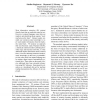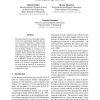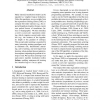618 search results - page 62 / 124 » Computational Models of Natural Language Argument |
104
click to vote
ACL
2012
13 years 7 days ago
2012
Most information extraction (IE) systems identify facts that are explicitly stated in text. However, in natural language, some facts are implicit, and identifying them requires â€...
EMNLP
2010
14 years 7 months ago
2010
This paper proposes a fast and simple unsupervised word segmentation algorithm that utilizes the local predictability of adjacent character sequences, while searching for a leaste...
EMNLP
2009
14 years 7 months ago
2009
We propose a new model for unsupervised POS tagging based on linguistic distinctions between open and closed-class items. Exploiting notions from current linguistic theory, the sy...
MODELS
2007
Springer
15 years 4 months ago
2007
Springer
The rising adoption and incorporation of computers into everyday life requires human-computer interaction methods to be efficient and easy to understand. Simultaneously, complexit...
EMNLP
2009
14 years 7 months ago
2009
Many statistical translation models can be regarded as weighted logical deduction. Under this paradigm, we use weights from the expectation semiring (Eisner, 2002), to compute fir...



